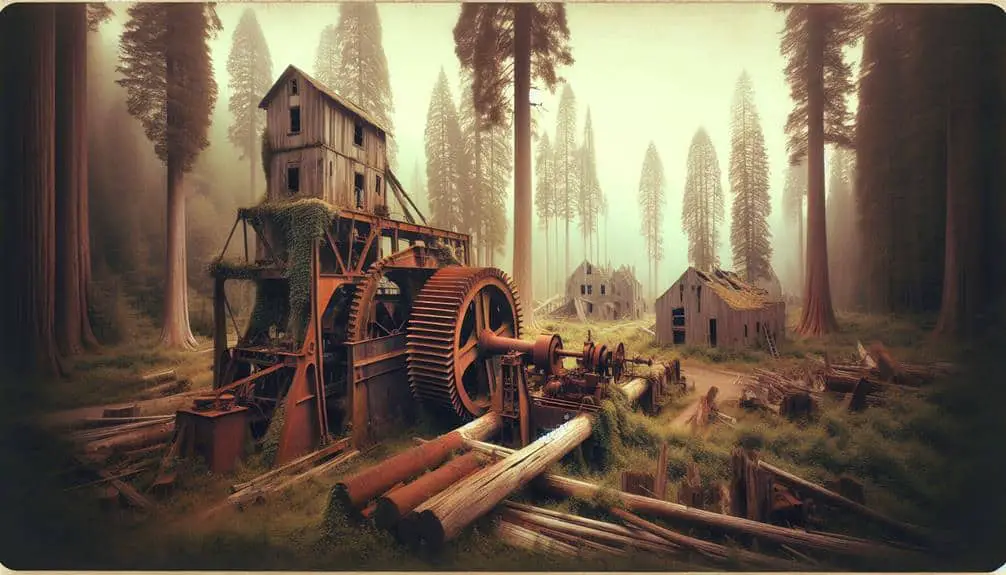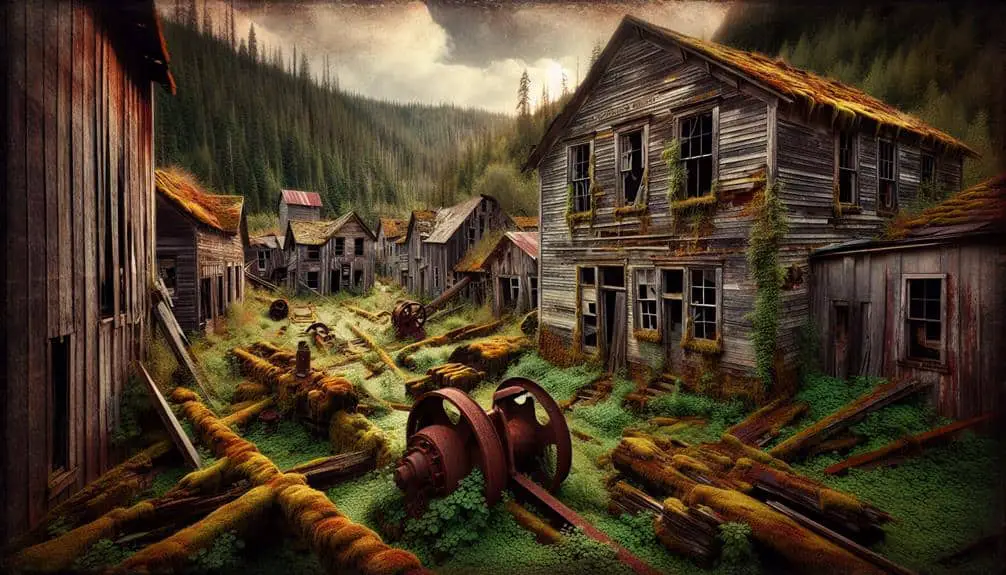To safeguard abandoned logging towns, begin by researching historical records and maps. Identify key locations and assess their economic impact. Consider the architecture and changes in logging practices. Understand the village's history and cultural significance. Evaluate decay and preservation needs like structural stability and artifact documentation. Implement restoration strategies using appropriate materials. Prevent further decay and engage with conservation organizations. Foster community collaboration for revitalization. Support sustainable development and organize clean-up days. Take steps to honor the legacy of these towns and guarantee their heritage endures.
Key Points
- Research historical records and maps to identify key abandoned logging towns.
- Assess decay and preservation needs, prioritizing unique structures at risk.
- Implement restoration strategies using authentic materials and conservation practices.
- Engage community efforts through collaboration, clean-up days, and partnerships.
- Ensure sustainable development for long-term preservation and community pride.
Identifying Key Abandoned Logging Towns
To begin identifying key abandoned logging towns, start by researching historical records and maps of logging activities in the region. Look for geographic locations where logging was important and had historical significance. These towns often played a vital role in the economic development of the area, leaving behind architectural structures that tell a story of a bygone era.
In your search, focus on the economic impact these logging towns had on the surrounding communities. Many of these towns thrived due to the logging industry, but as logging practices changed or resources depleted, they were eventually abandoned. Understanding the economic dynamics can provide insight into why these towns were established in specific locations and why they were eventually deserted.
Understanding the History of Logging Villages
Discover the rich history of logging villages to expose the intricate tapestry of their past, revealing the stories of resilience, industry, and change woven into the fabric of these once bustling communities. Logging towns hold immense historical significance, representing the pioneering spirit of early settlers and the industrial revolution's impact on remote regions. Understanding the history of these villages provides insight into the cultural heritage embedded in their abandoned structures and overgrown pathways.
- Echoes of Industry: Picture rusted sawmills standing as silent sentinels, resonating the once thunderous roar of machinery that drove the logging industry forward.
- Community Tales: Envision the laughter of families gathered around crackling fires, sharing stories of triumphs and struggles in the rugged wilderness that surrounded them.
- Nature's Reclamation: Imagine nature's relentless march reclaiming abandoned homes and streets, a poignant reminder of the impermanence of human endeavors in the face of time.
Unraveling the threads of history woven within logging villages offers a glimpse into the past, honoring the cultural heritage that shaped these now-deserted landscapes.
Assessing Current Decay and Preservation Needs
Evaluating the current state of decay and identifying the preservation needs of deserted logging towns reveals important insights into the challenges encountered in upholding the historical integrity of these formerly bustling communities. When examining the infrastructure, pay close attention to the structural stability of buildings, roads, and bridges. Documenting artifacts is vital to comprehend the cultural significance and historical value they hold. By appraising infrastructure, you can determine which areas require immediate attention to prevent further deterioration.
Make sure to document artifacts meticulously, noting their condition, location, and any significant details that could aid in their preservation. This information will be invaluable when developing a restoration plan. Assess the decay of wooden structures, looking out for signs of rot, termite damage, or water infiltration. Prioritize the preservation of unique structures or artifacts that are at risk of being lost to time. By thoroughly evaluating the infrastructure and documenting artifacts, you pave the way for effective restoration and conservation strategies in abandoned logging towns.
Implementing Restoration and Conservation Strategies
An integral aspect in the restoration and conservation of abandoned logging towns is the strategic implementation of preservation efforts based on thorough assessments and prioritization of key structures and artifacts. To effectively bring these towns back to life, consider the following:
- Restoration Techniques: Begin by evaluating the historical significance of each building and identifying the most urgent restoration needs. Utilize appropriate materials and traditional construction methods to maintain the authenticity of the structures while ensuring structural integrity.
- Conservation Initiatives: Implement proactive measures to prevent further decay, such as regular maintenance schedules and protective coatings for vulnerable surfaces. Engage with local conservation organizations to gain insights into best practices and access resources for long-term preservation projects.
- Sustainable Practices: Incorporate eco-friendly restoration techniques like using reclaimed materials, installing energy-efficient systems, and promoting biodiversity in green spaces. By adopting sustainable practices, you not only preserve the town's heritage but also contribute to environmental conservation efforts.
Engaging Community Efforts for Revitalization
To foster the revitalization of abandoned logging towns, actively engaging the community in restoration efforts is crucial for long-term sustainability and preservation. Community collaboration plays an essential role in the successful development of these towns, ensuring that historical sites are preserved while also creating opportunities for economic growth. Sustainable development is key, as it not only focuses on the immediate restoration needs but also looks towards the future to guarantee the continued prosperity of the town.
Engaging the community in revitalization projects can take various forms, such as organizing volunteer clean-up days, hosting fundraising events, or establishing partnerships with local businesses and organizations. By involving residents, former inhabitants, and other stakeholders in the process, a sense of ownership and pride is instilled in the town's restoration efforts, leading to a more sustainable and successful outcome.
Frequently Asked Questions
How Can We Ensure the Safety of Volunteers and Workers During the Restoration Process in Abandoned Logging Towns?
To guarantee safety during restoration in abandoned logging towns, implement stringent safety measures and thorough volunteer training. Prioritize hazard awareness, proper equipment use, and emergency protocols. By fostering a culture of safety, you protect everyone involved in the project.
Are There Any Legal Considerations or Permits Required for Restoring and Preserving Abandoned Logging Towns?
When restoring abandoned logging towns, legal requirements and the permitting process are vital. Understanding local regulations, obtaining necessary permits, and complying with zoning laws are essential steps to guarantee a successful preservation project.
What Are Some Potential Challenges or Obstacles That May Arise When Trying to Revitalize an Abandoned Logging Town?
When revitalizing an abandoned logging town, potential challenges include addressing environmental impact concerns and ensuring strong community engagement. Balancing preservation with progress is key to creating a sustainable future for these historical sites.
How Can We Effectively Communicate the Importance of Preserving These Historic Sites to the General Public?
To effectively communicate the importance of preserving historic sites to the general public, engage in public outreach through educational campaigns. Share compelling stories that resonate, sparking community involvement and a shared sense of pride.
Are There Any Funding Opportunities or Grants Available for Individuals or Groups Looking to Restore Abandoned Logging Towns?
Looking for funding opportunities to restore abandoned logging towns? Check out grants from historical preservation organizations or government agencies. Engage the community to rally support and showcase the importance of these historic sites.



